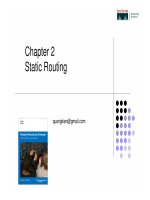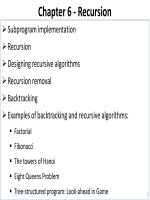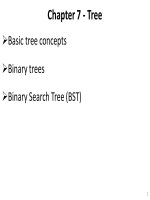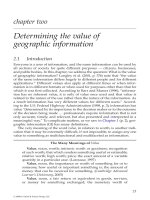Lecture Data security and encryption - Chapter 2: Classical encryption techniques
Bạn đang xem bản rút gọn của tài liệu. Xem và tải ngay bản đầy đủ của tài liệu tại đây (613.12 KB, 56 trang )
Data Security and Encryption
(CSE348)
1
Lecture # 2
2
Review
•
•
•
•
Course outline
Topic roadmap
Standards organizations
Security concepts
3
Computer Security
• Protection afforded to an automated
information system in order to attain the
applicable objectives of preserving the
integrity, availability and confidentiality of
information system resources (includes
hardware, software, firmware,
information/data, and telecommunications)
4
Key Security Concepts
5
CIA Triad
• These three concepts form what is often
referred to as the CIA triad Figure above.
• The three concepts embody the fundamental
security objectives for both data and for
information and computing services.
• FIPS PUB 199 provides a useful
characterization of these three objectives in
terms of requirements and the definition of a
loss of security in each category.
6
CIA Triad
• Confidentiality (covers both data
confidentiality and privacy):
• preserving authorized restrictions on
information access and disclosure, including
means for protecting personal privacy and
proprietary information.
• A loss of confidentiality is the unauthorized
disclosure of information.
7
CIA Triad
• Integrity (covers both data and system
integrity):
• Guarding against improper information
modification or destruction, and includes
ensuring information nonrepudiation and
authenticity.
• A loss of integrity is the unauthorized
modification or destruction of information.
8
CIA Triad
• Availability: Ensuring timely and reliable
access to and use of information. A loss of
availability is the disruption of access to or use
of information or an information system.
• Although the use of the CIA triad to define
security objectives is well established, some in
the security field feel that additional concepts
are needed to present a complete picture.
• Two of the most commonly mentioned are:
9
CIA Triad
• Authenticity: The property of being genuine
and being able to be verified and trusted;
confidence in the validity of a transmission, a
message, or message originator.
10
CIA Triad
• Accountability: The security goal that
generates the requirement for actions of an
entity to be traced uniquely to that entity.
11
Levels of Impact
• can define 3 levels of impact from a security
breach
– Low
– Moderate
– High
12
Levels of Impact
• Low: The loss could be expected to have a
limited adverse effect on organizational
operations, organizational assets, or
individuals.
• A limited adverse effect means that, for
example, the loss of confidentiality, integrity,
or availability might causes effect.
13
Levels of Impact
• degradation in mission capability to an extent
and duration that the organization is able to
perform its primary functions, but the
effectiveness of the functions is noticeably
reduced;
• result in minor damage to organizational
assets;
• result in minor financial loss; or
• result in minor harm to individuals.
14
Levels of Impact
• Moderate: The loss could be expected to have
a serious adverse effect on organizational
operations, organizational assets, or
individuals. A serious adverse effect means
that, for example, the loss might cause effect.
15
Levels of Impact
• a significant degradation in mission capability
and effectiveness of the functions is
significantly reduced;
• result in significant damage to oganizational
assets;
• result in significant financial loss; or
• result in significant harm to individuals that
does not involve loss of life or serious, life
threatening injuries.
16
Levels of Impact
• High: The loss could be expected to have a
severe or catastrophic adverse effect on
organizational operations, organizational
assets, or individuals. A severe or catastrophic
adverse effect means that, for example, the
loss might cause effect.
17
Levels of Impact
• a severe degradation in or loss of mission
capability to an extent and duration that the
organization is not able to perform one or
more of its primary functions;
• result in major damage to organizational
assets;
• result in major financial loss; or
• result in severe or catastrophic harm to
individuals involving loss of life or serious life
threatening injuries.
18
Examples of Security
Requirements
• confidentiality – student grades
• integrity – patient information
• availability – authentication service
19
Examples of Security
Requirements
• confidentiality – student grades
• integrity – patient information
• availability – authentication service
20
Confidentiality Example
• Student grade information is an asset whose
confidentiality is considered to be highly
important by students.
• Grade information should only be available to
students, their parents, and employees that
require the information to do their job.
• Student enrollment information may have a
moderate confidentiality rating.
21
Confidentiality Example
• While still covered by FERPA, this
information is seen by more people on a daily
basis, is less likely to be targeted than grade
information, and results in less damage if
disclosed.
• Directory information, such as lists of students
or faculty or departmental lists, may be
assigned a low confidentiality rating.
• Freely available to the public and published on
a school's Web site.
22
Integrity Example
• Consider a hospital patient's allergy
information stored in a database.
• The doctor should be able to trust that the
information is correct and current.
• Now suppose that an employee (e.g., a nurse)
who is authorized to view and update this
information deliberately falsifies the data to
cause harm to the hospital.
23
Integrity Example
• The database needs to be restored to a trusted
basis quickly, and it should be possible to trace
the error back to the person responsible.
• Patient allergy information is an example of an
asset with a high requirement for integrity.
• Inaccurate information could result in serious
harm or death to a patient and expose the
hospital to massive liability.
24
Availability Example
• The more critical a component or service, the
higher is the level of availability required.
• Consider a system that provides authentication
services
• An interruption of service results in the
inability for customers to access computing
resources.
• loss of service translates into a large financial
loss productivity and potential customer loss.
25









